Introduction
Understanding the upper obliques is essential for anyone looking to enhance their core strength and overall physical performance. These muscles, located on the sides of the abdomen, are pivotal not only for athletes but for everyone aiming to improve their daily functionality and posture.
By prioritizing the development of the upper obliques, individuals can unlock a myriad of benefits—from better athletic performance to injury prevention and enhanced recovery.
This article delves into the following topics:
- The anatomy of the upper obliques
- Effective exercises to strengthen them
- Essential techniques to ensure optimal training
- Importance of recovery strategies
- Common pitfalls to avoid
Empowering readers to cultivate a robust core that supports their fitness journey and everyday activities.
Understanding the Anatomy and Function of Upper Obliques
The upper obliques are the upper side muscles, strategically located on the sides of your abdomen, running diagonally from your lower ribs to your pelvis, playing an indispensable role in trunk rotation, lateral flexion, and overall core stability. These tissues are not just vital for athletes; their strength is crucial for everyone, enhancing athletic performance and supporting daily activities. A strong group of upper obliques contributes to improved posture and injury prevention, enabling you to move with confidence and agility.
A notable example is a 26-year-old Japanese handball player who fully recovered from a grade III internal oblique muscle strain after six weeks, highlighting the importance of oblique strength in recovery. The Internal Oblique starts from the inguinal ligament and iliac crest, and is responsible for trunk compression, flexion, lateral flexion, and same-sided rotation, highlighting its role in stability of the torso. As noted by strength and conditioning specialist Dwayne Peterson, sound central strength is required to produce the forces needed to complete the complex nature of movements.
This insight underscores the necessity of incorporating targeted exercises into your routine. Furthermore, the Double Leg Lowering Test for Stability effectively assesses abdominal strength and stability, illustrating the practical application of these concepts in athletic training. By prioritizing the development of your upper obliques, you can significantly enhance your core strength and stability, empowering you for both athletic pursuits and daily activities.
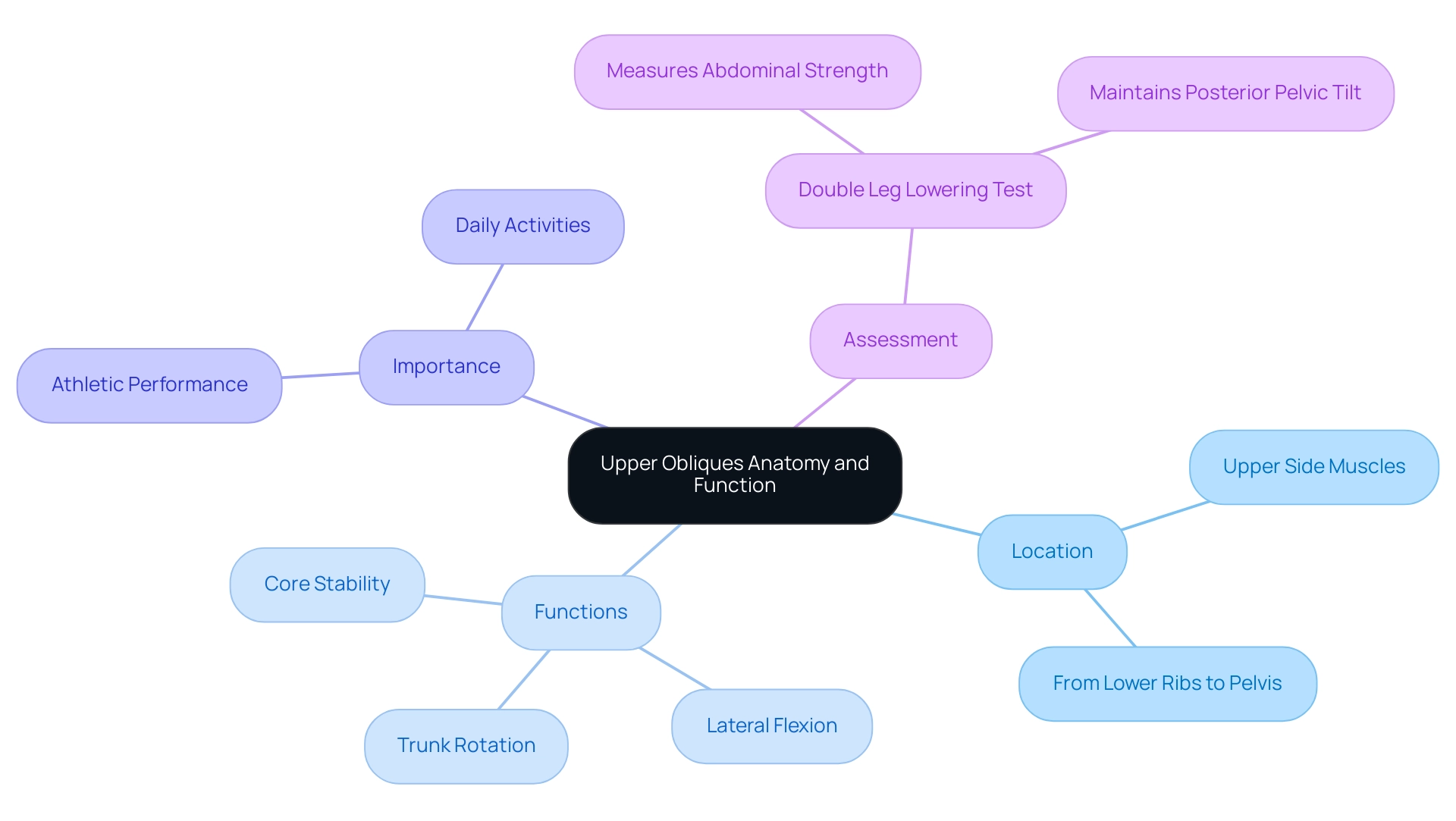
Top Exercises to Target and Strengthen Your Upper Obliques
To effectively target and strengthen your upper obliques, consider including the following exercises in your routine:
-
Lateral Plank:
Begin by lying on your lateral position, propping your body up on one forearm. Ensure that your body forms a straight line from head to toe.Hold this position for at least 30 seconds, maintaining engagement in your core. Remember to alternate positions and repeat to achieve balanced strength. According to normative values for plank exercise duration, holding a lateral plank for over 2 minutes is considered Above Average, while exceeding 6 minutes is categorized as Excellent.
This benchmark can help you gauge your performance.
-
Russian Twists:
Sit on the floor with your knees bent, leaning back slightly to engage your core. With a weight or medicine ball in hand, twist your torso back and forth.Aim for 15-20 repetitions on each flank to maximize muscle engagement, as this exercise has shown significant activation in the lateral muscles, with a normalized EMG indicating substantial muscle engagement.
-
Bicycle Crunches:
Lie flat on your back and elevate your legs into a tabletop position. As you alternate bringing your elbow to the opposite knee while extending the other leg, aim for 15-20 repetitions on each part.This dynamic movement not only targets the obliques but also engages the entire core.
-
Oblique V-Ups:
Lying on your flank, lift both your legs and upper body simultaneously while reaching your hand toward your feet. Complete 10-15 repetitions on each flank.This exercise is effective for building strength and definition in the upper obliques. By incorporating these exercises that target the upper obliques into your weekly fitness routine, you can enhance your team's strength and well-being, fostering a culture of health and resilience. Remember, as Gary Smith, a sports chiropractor, emphasizes, 'Fantastic! Easy to use and implement.'
These exercises connect pain management and performance, making them vital for anyone dedicated to training the central body. Furthermore, for the side plank, make sure to align your body correctly, engage your midsection, avoid neck strain, and concentrate on steady breathing to maintain stability and prevent injury.
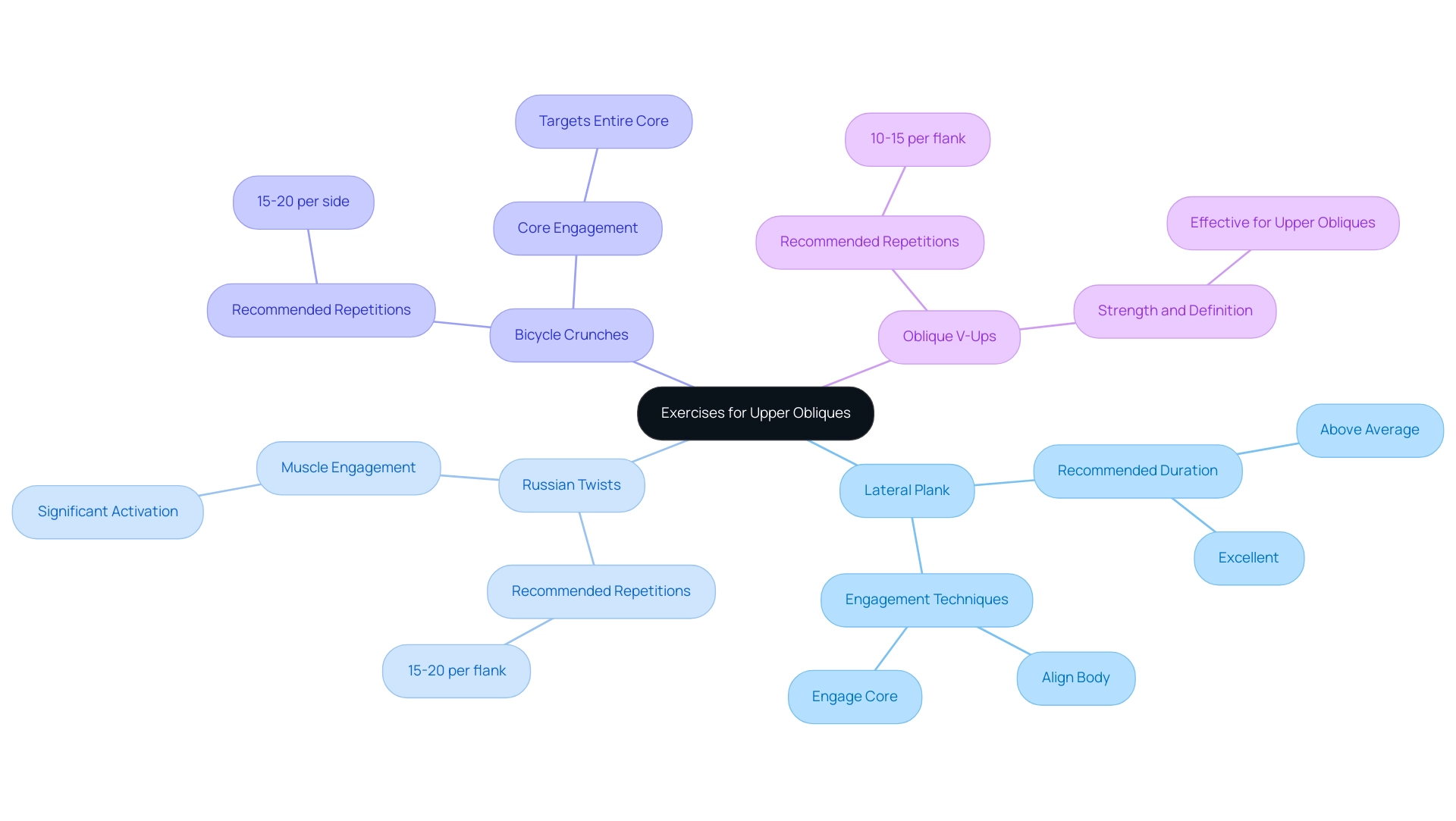
Mastering Proper Form: Key Techniques for Oblique Exercises
To maximize the effectiveness of your oblique workouts, mastering key techniques is essential. Begin by Activating Your Center: Engaging your central body areas before any exercise not only offers stability but also enhances your overall performance. As Weimar correctly mentions,
The central tissues are essential because they support the middle of the body so that the parts of the appendicular skeleton can exert force against a stable platform.
This foundational engagement is crucial for effective training.
Next, focus on Controlled Movements. Rather than rushing through repetitions, emphasize slow, deliberate motions. This approach not only enhances muscle engagement but also significantly reduces the risk of injury, which is vital as improper form can lead to higher injury rates.
In fact, training sessions greater than 30 minutes have been shown to improve throwing and hitting velocity or distance performance, highlighting the benefits of longer workouts in relation to core engagement.
Alignment is another critical aspect; maintaining proper body posture throughout each exercise is essential. For example, during a side plank, ensure your body forms a straight line from head to heels. This alignment fosters engagement of the targeted muscles and supports overall stability.
Moreover, enhancing the central muscles can lead to a decreased likelihood of injuries involving the lower extremities, particularly for older adults, as demonstrated in case studies.
Finally, pay attention to your Breathing. Breathe out during the exertion phase—such as when twisting—and inhale during the relaxation phase. This rhythmic breathing pattern not only aids in maintaining stability but also boosts your workout flow.
By incorporating these techniques, you can greatly enhance your workout effectiveness, leading to improved overall performance while promoting a robust center. Remember, as the American Heart Association emphasizes, muscle strengthening activities should be prioritized for all age groups, particularly those that engage the core, reinforcing its importance in stabilizing the body during physical activities.
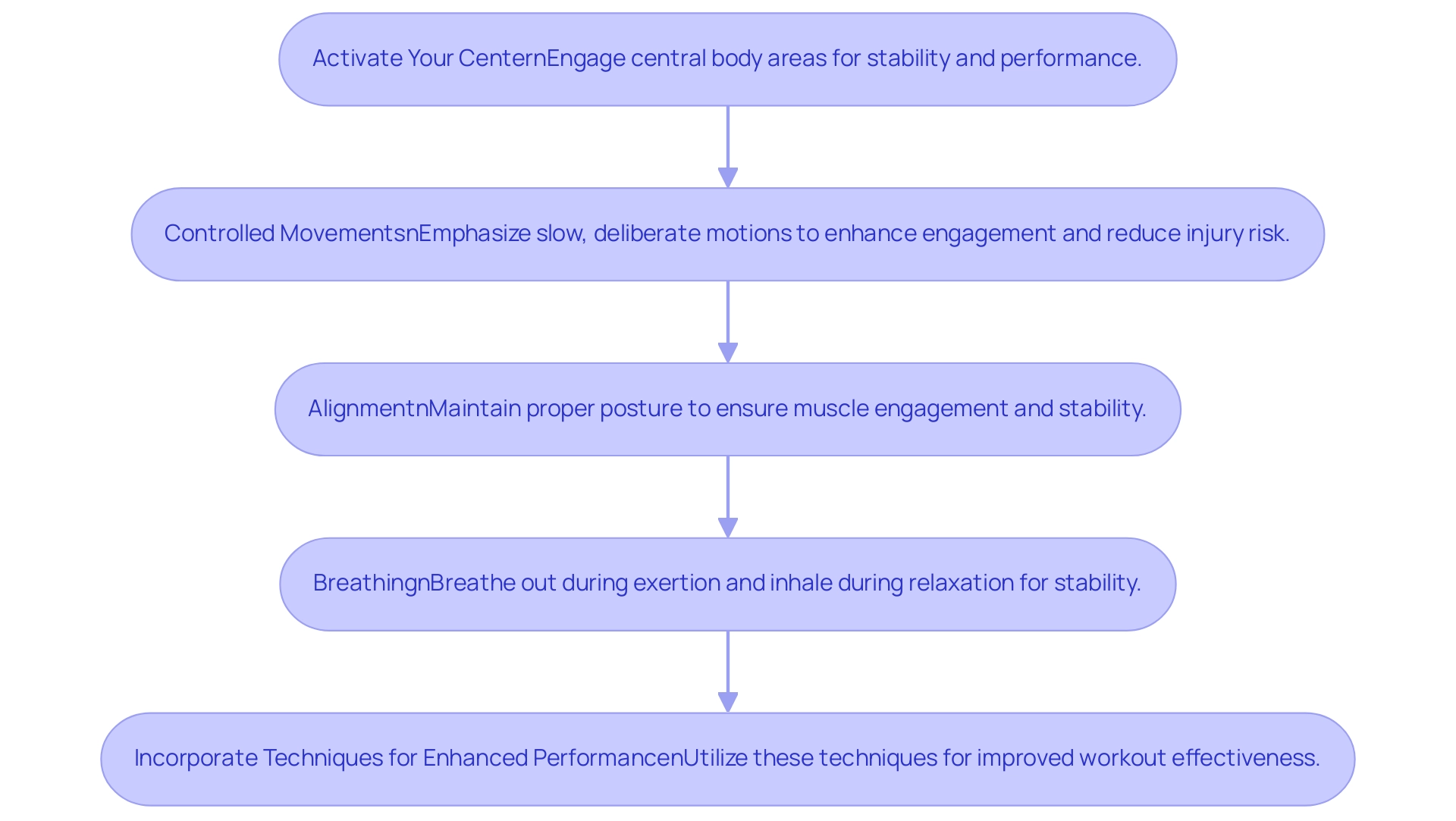
Incorporating Stretching and Recovery for Optimal Oblique Health
To achieve optimal physical health, integrating effective stretching and recovery strategies into your routine is essential. Consider these motivational approaches:
- Post-Workout Stretching: Allocate 5-10 minutes after your workout specifically for stretching your obliques. Incorporating side bends and torso twists not only enhances flexibility but also prevents stiffness, promoting a more agile core. While stretching can help reduce soreness, it will not completely eliminate it, making it a vital part of your recovery strategy.
- Active Recovery: Embrace low-intensity activities like walking or yoga on your rest days. These practices stimulate blood circulation and are proven to reduce soreness, making them essential for recovery.
- Hydration and Nutrition: Maintain proper hydration and a balanced diet rich in protein. This nutritional emphasis is vital for tissue repair and overall recovery, ensuring your body is prepared for the next workout.
- Rest Days: Prioritize regular rest days in your training schedule. Allowing your body to recover is not just about preventing overtraining; it significantly enhances your performance and prepares you for future challenges.
By embracing these recovery strategies, you empower your fitness journey while ensuring your upper obliques remain strong and healthy. Remember, as mentioned by Professor José Alberto Duarte, 'proactive measures in recovery can lead to substantial improvements in overall physical health.' Additionally, consider the Orgono Sports Recovery Supplement, formulated with organic silica and glycine, which promotes collagen formation essential for the structure of bones and joints.
This supplement enhances cartilage, tendons, and offers crucial support for joint health and recovery. Together, these practices lay the foundation for sustained fitness success.
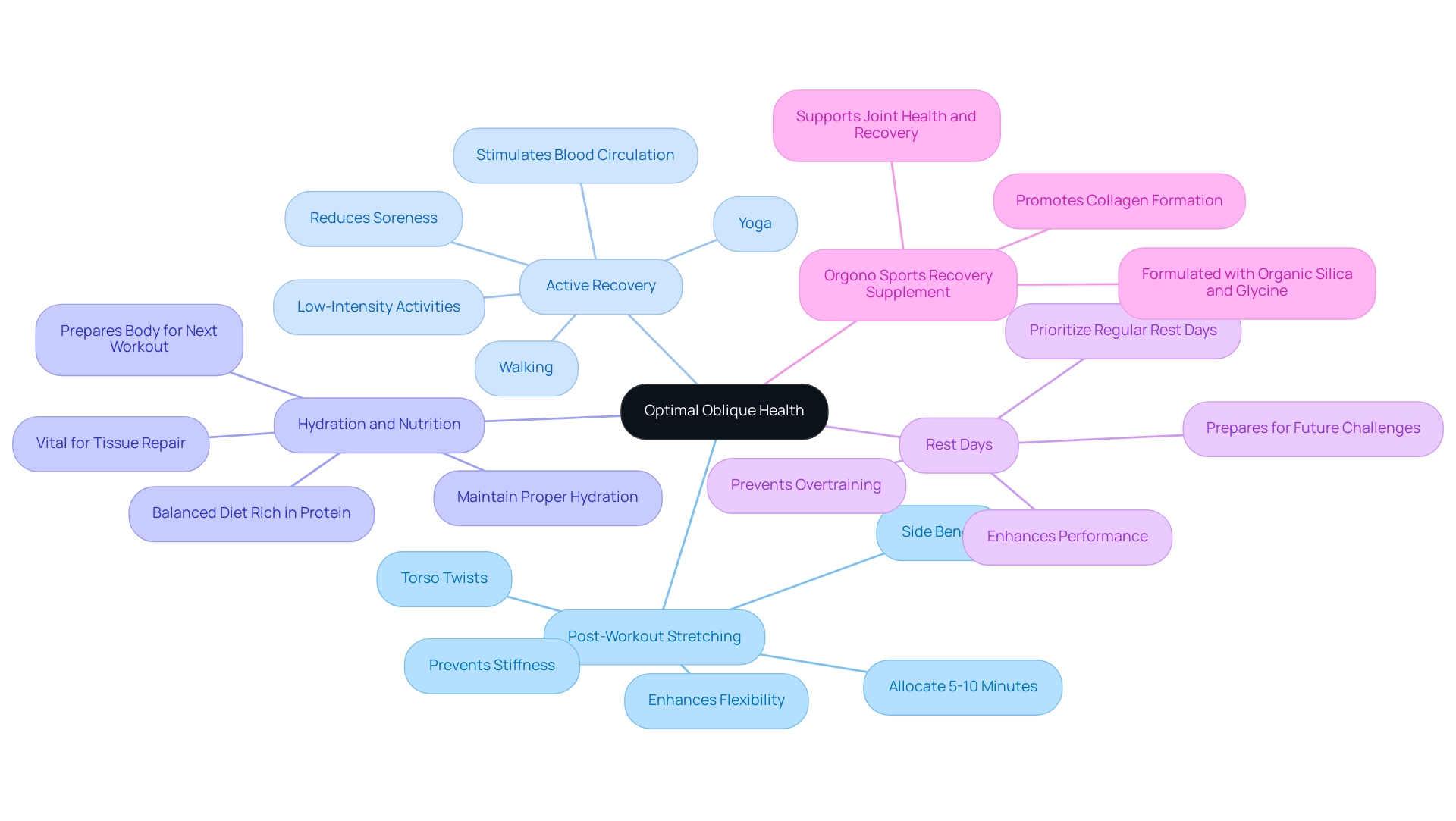
Avoiding Common Mistakes in Upper Oblique Training
To enhance the effectiveness of your upper oblique training, it's crucial to steer clear of these common pitfalls:
-
Neglecting Other Core Muscles: Concentrating solely on upper obliques can lead to significant muscle imbalances. A well-rounded approach that incorporates exercises targeting the entire core will ensure balanced strength and functionality. For instance, participants in a study held a 4.5 kg dumbbell at heights of 20 cm, 40 cm, and 60 cm above their fifth lumbar spine, highlighting the importance of varied training to avoid imbalances.
-
Using Momentum: Reliance on momentum during exercises can dramatically reduce engagement and elevate the risk of injury. Instead, focus on executing controlled movements that maximize muscle activation and effectiveness. The case study titled "Muscle Coactivation Patterns" found no significant changes in antagonist coactivation ratios, emphasizing that improper technique can hinder progress.
-
Inconsistent Training: Regular practice of oblique exercises is vital for achieving visible results. Inconsistency not only hinders progress but can also lead to frustration and stagnation. The balance scale results showed significant improvement for the left foot in the anteroposterior direction, demonstrating that consistent training can lead to measurable benefits.
-
Ignoring Pain: If you encounter discomfort during your workouts, it’s essential to stop and evaluate your form. Ignoring pain can lead to serious injuries, undermining your fitness journey.
By steering clear of these common mistakes, you empower yourself and your team to enhance workout effectiveness and reach fitness goals with greater efficiency. Remember, as Clayton wisely stated, "Inspire, motivate, and be creative"—this mantra can drive a culture of health and well-being in your organization.
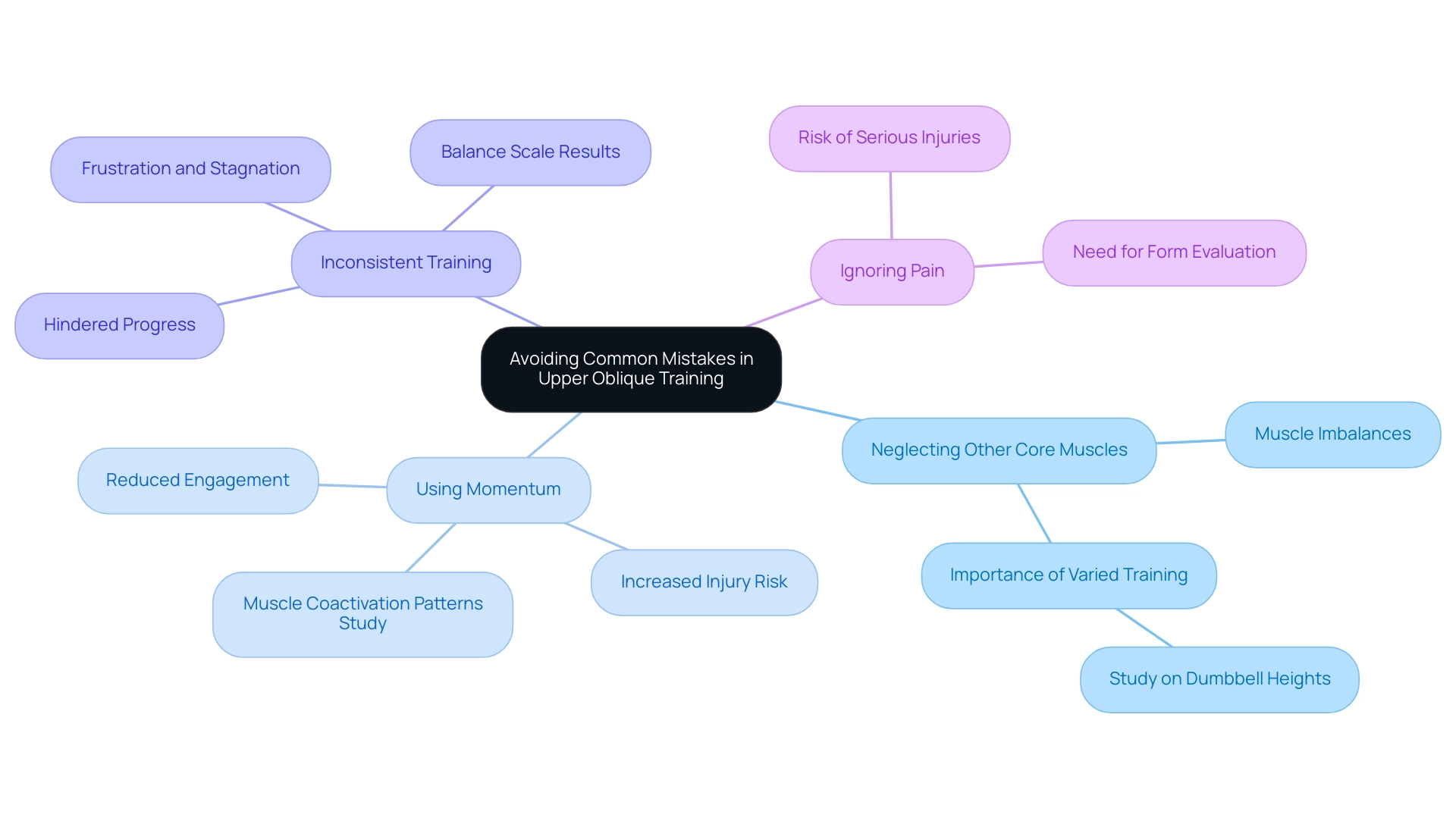
Conclusion
Understanding and strengthening the upper obliques is vital for anyone committed to enhancing core strength and overall physical performance. These muscles play a crucial role in trunk rotation, lateral flexion, and core stability, impacting not only athletic performance but everyday functionality. By incorporating targeted exercises like:
- Side planks
- Russian twists
- Bicycle crunches
into a regular fitness routine, individuals can significantly improve their core strength while also fostering resilience in their physical activities.
Mastering proper form and technique is equally important. Engaging the core, maintaining controlled movements, and ensuring proper alignment during exercises can enhance effectiveness and reduce injury risks. Additionally, integrating stretching and recovery strategies—such as:
- Post-workout stretching
- Active recovery
- Proper hydration
ensures that the obliques remain healthy and strong.
Avoiding common pitfalls, such as neglecting other core muscles and using momentum, contributes to a balanced training regimen that promotes overall core health. By prioritizing these components, individuals can cultivate a robust core that not only supports their fitness journey but also enhances daily activities and performance. Embrace the journey of developing your upper obliques, and witness the transformative power of a strong core in achieving fitness goals and improving overall well-being.




